


Q You may only use class materials for this assignment, which includes the lecture video, the primary source documents, and the Traditions and Encounters text (optional). You will get a 0 if you use any outside materials or plagiarize on this assignment. Once you've chosen your item from 2.5.a Unit 2 Images, Quotes, and Terms, write one to two paragraphs on the significance of your item. You may want to: • Explain how your item is a cause or a consequence of some event. • Explain how your item exemplified some trend or movement or ideology. • Explain how your item ties into one of our class themes. • Explain any other way this item is significant. Here's a reminder of our class themes: • The uniqueness of various cultures and the impact of cross-cultural exchange. • The role of religion in shaping world history since 1500. • The role of government in shaping world history since 1500. ________________________________________ Requirements: • 1-2 paragraphs • Use of complete sentences and paragraphs. Do not use bullet points (like I've just done a here). • A clearly identified item. • A thorough explanation of the significance of your item • An explanation which puts your item in historical context. • An explanation which is factually correct. Click on the "Start Assignment," in the upper right corner to submit your response. Your assignment is due on Sunday 02/05 at 11:59 pm and is worth 10 points. Review the rubric below to see how I grade these assignments. ________________________________________ Rubric Homework Rubric Homework Rubric Criteria Ratings Pts This criterion is linked to a Learning OutcomeLength The response is one or two paragraphs long. 1 pts Excellent The response is one or two paragraphs long 0 pts Unsatisfactory The response is less than one full paragraph or more than two paragraphs long. 1 pts This criterion is linked to a Learning OutcomeClearly Identified Item The item is clearly identified, explained, and described 2 pts Excellent The item is clearly identified, explained, and described. 1 pts Satisfactory The item is vaguely or inadequately mentioned, explained, or described. 0 pts Unsatisfactory There is no discernible attempt to identify, explain, or describe the item. 2 pts This criterion is linked to a Learning OutcomeSignificance There is a clear, thorough, and factually correct explanation of the significance of your item 5 pts Excellent The explanation has all three of the criteria (clear, thorough, and factually correct). 3 pts Satisfactory The explanation is missing one of the criteria (clear, thorough, and factually correct). 1 pts Needs Work The explanation is missing two of the criteria (clear, thorough, and factually correct). 0 pts Unsatisfactory The explanation is missing all three criteria (clear, thorough, and factually correct). 5 pts This criterion is linked to a Learning OutcomeHistorical Context The item is put into historical context and has a date attached to it. 2 pts Excellent The item is put into historical context and has a date attached to it. 1 pts Satisfactory The response is either missing historical context or a reference to a date, 0 pts Unsatisfactory The response is missing both historical context and a reference to a date 2 pts Total Points: 10
View Related Questions